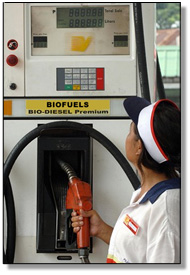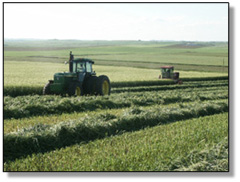Nebraska Positioned to be a Leader in Expanding Biofuels Industry
 Opportunities for ethanol and other biofuels are expected to expand significantly in the coming years, and the Midwest is uniquely positioned to become the "Saudi Arabia of biorenewables," an expert said at a biofuels conference July 20, 2005.
Opportunities for ethanol and other biofuels are expected to expand significantly in the coming years, and the Midwest is uniquely positioned to become the "Saudi Arabia of biorenewables," an expert said at a biofuels conference July 20, 2005.More than 175 representatives of industry, commodity and environmental groups, agricultural producers, government and the University of Nebraska-Lincoln gathered at the Nebraska Biofuel Renewables Energy Roadmap Workshop to begin plotting how the state can capitalize on this emerging industry.
Nebraska is off to a good start, Gov. Dave Heineman said. Ten years ago, the state had one ethanol plant, producing 12 million gallons of the fuel a year. Now, there are 11 plants producing 540 million gallons a year, and another 10 are in various stages of development, he added.
The growth in the biofuel industry brings new economic development to rural Nebraska, creates a new market for the state's crops and other agricultural products and can help reduce the nation's dependence on foreign oil, Heineman said.
Pending federal energy legislation proposes a doubling of biofuel production by 2012, to 8 billion gallons a year.

Stars Aligning
"Why can't Nebraska be No. 1 in the nation in attracting that development?" asked Ken Cassman, UNL professor of agronomy and a conference organizer. "The stars are aligning ... There's an incredible opportunity." The biofuel industry is uniquely suited for rural economic development, he added.
The director of the U.S. Department of Agriculture's Office of Energy Policy and New Uses said the ethanol industry is largely past its earlier growing pains. "This is in some sense the golden age of ethanol," Roger Conway said.
Fossil fuel prices do not reflect the negative consequences of fossil fuels, he added, including the health and environmental impacts.
Still, there's disagreement over the energy efficiency of ethanol production. UNL soil scientist Dan Walters disputed a recently published study claiming that corn ethanol production requires more fossil fuel than it produces. Walters said numerous scientific studies have clearly documented ethanol's positive energy balance. The recent study by researchers at Cornell University and the University of California-Berkeley stating that ethanol production uses 29 percent more energy than it produces used outdated numbers that don't reflect the significant efficiency gains in agricultural and ethanol production.
Walters' analysis of ethanol energy balance showed that turning corn into ethanol produces 30 to 40 percent more energy than required to produce the corn, transport it, process it and deliver it to the pump.
 Production of biofuels other than ethanol also is increasing, Conway said.
Production of biofuels other than ethanol also is increasing, Conway said.For example, 20 plants nationwide currently produce biodiesel, a blend of diesel and soybean or other vegetable oil or animal fat. Ten more plants are in development, Conway said. Annual production could expand from the current 150 million gallons to as much as 400 million gallons.
Building a BioEconomy
Robert C. Brown, head of Iowa State University's Center for Sustainable Environmental Technologies, urged biofuel boosters to think even bigger. Just as petroleum is used to produce a myriad of products in addition to fuel, he said, biorenewables also can be used to produce everything from transportation fuel to power, chemicals and plastics.
Brown used the word "bioeconomy" to capture this more expansive view that is driving strategic planning in Iowa, where officials have set ambitious goals for the Hawkeye state's share of the emerging national production of bio-based products. Brown said there's no reason Nebraska can't be similarly aggressive.
"The Midwest is the Saudi Arabia of biorenewables," Brown said.
David Hallberg is among the entrepreneurs who are bullish on Nebraska's biorenewables outlook. His company, E3 Biofuels of Omaha, is building the state's first biorefinery near Mead.
The plant, expected to be in operation by spring 2006, is being built near an existing feedlot. The plant's anaerobic digester will turn feedlot waste into biogas that will fuel ethanol production.
 Distillers grains from the ethanol production will be fed to the cattle. This integrated system will maximize energy yield and environmental quality.
Distillers grains from the ethanol production will be fed to the cattle. This integrated system will maximize energy yield and environmental quality."The raw materials of cattle and corn give Nebraska huge advantages," Hallberg said.
Participants split into four groups to identify priorities and needs for enhancing investment in and development of Nebraska's biofuel industry. Participants identified Nebraska's comparative advantages, including infrastructure, natural resources, production systems and the human factor. Other groups outlined research, education, policy and capital investment priorities and needs. Conference organizers plan to use this information as a foundation for future biofuels efforts. A complete list of the presentation and conference results is on a University of Nebraska website.
The workshop was sponsored with federal funds by the Nebraska Energy Office and the university's Institute of Agriculture and Natural Resources.